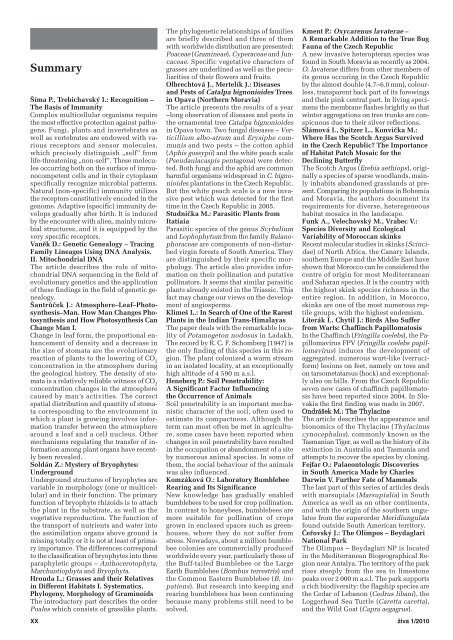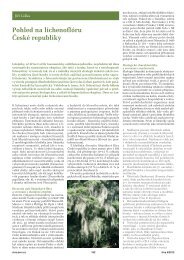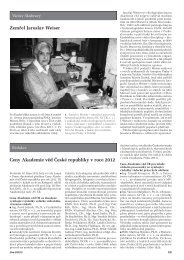Jeskyně. In: Petr Mackovčin a Miroslav Sedláček (eds.) - Živa ...
Jeskyně. In: Petr Mackovčin a Miroslav Sedláček (eds.) - Živa ...
Jeskyně. In: Petr Mackovčin a Miroslav Sedláček (eds.) - Živa ...
You also want an ePaper? Increase the reach of your titles
YUMPU automatically turns print PDFs into web optimized ePapers that Google loves.
Summary<br />
Šíma P., Trebichavský I.: Recognition –<br />
The Basis of Immunity<br />
Complex multicellular organisms require<br />
the most effective protection against patho -<br />
gens. Fungi, plants and invertebrates as<br />
well as vertebrates are endowed with va -<br />
rious receptors and sensor molecules,<br />
which precisely distinguish „self” from<br />
life-threatening „non-self”. These molecules<br />
occurring both on the surface of immunocompetent<br />
cells and in their cytoplasm<br />
specifically recognize microbial patterns.<br />
Natural (non-specific) immunity utilizes<br />
the receptors constitutively encoded in the<br />
genome. Adaptive (specific) immunity de -<br />
velops gradually after birth. It is induced<br />
by the encounter with alien, mainly micro -<br />
bial structures, and it is equipped by the<br />
very specific receptors.<br />
Vaněk D.: Genetic Genealogy – Tracing<br />
Family Lineages Using DNA Analysis.<br />
II. Mitochondrial DNA<br />
The article describes the role of mitochondrial<br />
DNA sequencing in the field of<br />
evolutionary genetics and the application<br />
of these findings in the field of genetic ge -<br />
nealogy.<br />
Šantrůček J.: Atmosphere–Leaf– Pho to -<br />
synthesis–Man. How Man Changes Pho -<br />
tosynthesis and How Photosynthesis Can<br />
Change Man I.<br />
Change in leaf form, the proportional en -<br />
hancement of density and a decrease in<br />
the size of stomata are the evolutionary<br />
reaction of plants to the lowering of CO 2<br />
concentration in the atmosphere during<br />
the geological history. The density of stomata<br />
is a relatively reliable witness of CO 2<br />
concentration changes in the atmosphere<br />
caused by man’s activi ties. The correct<br />
spatial distribution and quantity of stoma -<br />
ta corresponding to the environment in<br />
which a plant is growing in volves information<br />
transfer between the atmosphere<br />
around a leaf and a cell nucleus. Other<br />
mechanisms regulating the transfer of in -<br />
formation among plant organs have recently<br />
been revealed.<br />
Soldán Z.: Mystery of Bryophytes:<br />
Underground<br />
Underground structures of bryophytes are<br />
variable in morphology (one or multicel -<br />
lular) and in their function. The primary<br />
function of bryophyte rhizoids is to attach<br />
the plant in the substrate, as well as the<br />
vegetative reproduction. The function of<br />
the transport of nutrients and water into<br />
the assimilation organs above ground is<br />
missing totally or it is not at least of prima -<br />
ry importance. The differences correspond<br />
to the classification of bryophytes into three<br />
paraphyletic groups – An thocerotophyta,<br />
Marchantiophyta and Bryo phyta.<br />
Hrouda L.: Grasses and their Relatives<br />
in Different Habitats I. Systematics,<br />
Phylogeny, Morphology of Graminoids<br />
The introductory part describes the order<br />
Poales which consists of grasslike plants.<br />
The phylogenetic relationships of fami lies<br />
are briefly described and three of them<br />
with worldwide distribution are presented:<br />
Poaceae (Gramineae), Cyperaceae and Juncaceae.<br />
Specific vegetative characters of<br />
grasses are underlined as well as the peculiarities<br />
of their flowers and fruits.<br />
Olbrechtová J., Mertelík J.: Diseases<br />
and Pests of Catalpa bignonioides Trees<br />
in Opava (Northern Moravia)<br />
The article presents the results of a year<br />
–long observation of diseases and pests in<br />
the ornamental tree Catalpa bignonioides<br />
in Opava town. Two fungal diseases – Verticillium<br />
albo-atrum and Erysiphe communis<br />
and two pests – the cotton aphid<br />
(Aphis gossypii) and the white peach scale<br />
(Pseudaulacaspis pentagona) were detected.<br />
Both fungi and the aphid are common<br />
harmful organisms widespread in C. bignonioides<br />
plantations in the Czech Republic.<br />
But the white peach scale is a new invasive<br />
pest which was de tected for the first<br />
time in the Czech Republic in 2005.<br />
Studnička M.: Parasitic Plants from<br />
Itatiaia<br />
Parasitic species of the genus Scybalium<br />
and Lophophytum from the family Balano -<br />
phoraceae are components of non-disturbed<br />
virgin forests of South America. They<br />
are distinguished by their specific mor -<br />
phology. The article also provides information<br />
on their pollination and putative<br />
pollinators. It seems that similar parasitic<br />
plants already existed in the Triassic. This<br />
fact may change our views on the develop -<br />
ment of angiosperms.<br />
Klimeš L.: <strong>In</strong> Search of One of the Ra rest<br />
Plants in the <strong>In</strong>dian Trans-Himalayas<br />
The paper deals with the remarkable locality<br />
of Potamogeton nodosus in Ladakh.<br />
The record by R. C. F. Schomberg (1947) is<br />
the only finding of this species in this re -<br />
gion. The plant colonized a warm stream<br />
in an isolated locality, at an exceptionally<br />
high altitude of 4 590 m a.s.l.<br />
Heneberg P.: Soil Penetrability:<br />
A Significant Factor <strong>In</strong>fluencing<br />
the Occurrence of Animals<br />
Soil penetrability is an important mechanistic<br />
character of the soil, often used to<br />
estimate its compactness. Although the<br />
term can most often be met in agriculture,<br />
some cases have been reported when<br />
changes in soil penetrability have resulted<br />
in the occupation or abandonment of a site<br />
by numerous animal species. <strong>In</strong> some of<br />
them, the social behaviour of the animals<br />
was also influenced.<br />
Komzáková O.: Laboratory Bumblebee<br />
Rearing and Its Significance<br />
New knowledge has gradually enabled<br />
bumblebees to be used for crop pollina tion.<br />
<strong>In</strong> contrast to honeybees, bumblebees are<br />
more suitable for pollination of crops<br />
grown in enclosed spaces such as greenhouses,<br />
where they do not suffer from<br />
stress. Nowadays, about a million bumble -<br />
bee colonies are commercially produced<br />
worldwide every year, particularly those of<br />
the Buff-tailed Bumblebee or the Large<br />
Earth Bumblebee (Bombus terrestris) and<br />
the Common Eastern Bumblebee (B. im -<br />
patiens). But research into keeping and<br />
rearing bumblebees has been continuing<br />
because many problems still need to be<br />
solved.<br />
Kment P.: Oxycarenus lavaterae –<br />
A Remarkable Addition to the True Bug<br />
Fauna of the Czech Republic<br />
A new invasive heteropteran species was<br />
found in South Moravia as recently as 2004.<br />
O. lavaterae differs from other members of<br />
its genus occuring in the Czech Republic<br />
by the almost double (4.7–6.0 mm), colourless,<br />
transparent back part of its forewings<br />
and their pink central part. <strong>In</strong> living speci -<br />
mens the membrane flashes brightly so that<br />
winter aggregations on tree trunks are conspicuous<br />
due to their silver reflections.<br />
Slámová I., Spitzer L., Konvička M.:<br />
Where Has the Scotch Argus Survived<br />
in the Czech Republic? The Importance<br />
of Habitat Patch Mosaic for the<br />
Declining Butterfly<br />
The Scotch Argus (Erebia aethiops), origi -<br />
nally a species of sparse woodlands, mainly<br />
inhabits abandoned grasslands at present.<br />
Comparing its populations in Bo hemia<br />
and Moravia, the authors document its<br />
requirements for diverse, heteregeneous<br />
habitat mosaics in the landscape.<br />
Funk A., Velechovský M., Vrabec V.:<br />
Species Diversity and Ecological<br />
Variability of Moroccan skinks<br />
Recent molecular studies in skinks (Scinci -<br />
dae) of North Africa, the Canary Islands,<br />
southern Europe and the Middle East have<br />
shown that Morocco can be considered the<br />
centre of origin for most Mediterranean<br />
and Saharan species. It is the country with<br />
the highest skink species richness in the<br />
entire region. <strong>In</strong> addition, in Mo rocco,<br />
skinks are one of the most numerous reptile<br />
groups, with the highest endemism.<br />
Literák I., Chytil J.: Birds Also Suffer<br />
from Warts: Chaffinch Papillomatosis<br />
<strong>In</strong> the Chaffinch (Fringilla coelebs), the Pa -<br />
pillomavirus FPV (Fringilla coelebs pa pil -<br />
lomavirus) induces the development of<br />
aggregated, numerous wart-like (verruciform)<br />
lesions on feet, namely on toes and<br />
on tarsometatarsus (hock) and exceptionally<br />
also on bills. From the Czech Republic<br />
seven new cases of chaffinch papillomatosis<br />
have been reported since 2004. <strong>In</strong> Slovakia<br />
the first finding was made in 2007.<br />
Ondrášek M.: The Thylacine<br />
The article describes the appearance and<br />
bionomics of the Thylacine (Thylacinus<br />
cynocephalus), commonly known as the<br />
Tasmanian Tiger, as well as the history of its<br />
extinction in Australia and Tasmania and<br />
attempts to recover the species by cloning.<br />
Fejfar O.: Palaeontologic Discoveries<br />
in South America Made by Charles<br />
Darwin V. Further Fate of Mammals<br />
The last part of this series of articles deals<br />
with marsupials (Marsupialia) in South<br />
America as well as on other continents,<br />
and with the origin of the southern ungulates<br />
from the superorder Meridiungulata<br />
found outside South American territory.<br />
Čeřovský J.: The Olimpos – Beydaglari<br />
National Park<br />
The Olimpos – Beydaglari NP is located<br />
in the Mediterranean Biogeogra phical Re -<br />
gion near Antalya. The territory of the park<br />
rises steeply from the sea to limestone<br />
peaks over 2 000 m a.s.l. The park supports<br />
a rich biodiversity: the flagship species are<br />
the Cedar of Lebanon (Cedrus libani), the<br />
Loggerhead Sea Turtle (Caretta caretta),<br />
and the Wild Goat (Capra aegagrus).<br />
XX živa 1/2010










